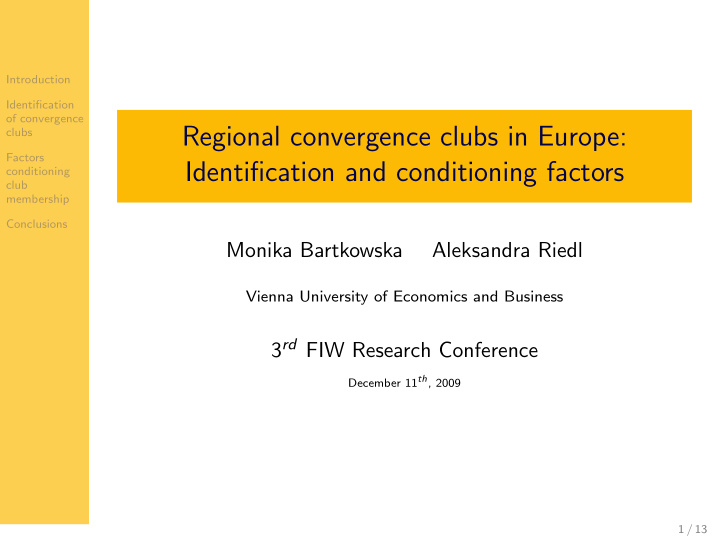



Introduction Identification of convergence Regional convergence clubs in Europe: clubs Factors Identification and conditioning factors conditioning club membership Conclusions Monika Bartkowska Aleksandra Riedl Vienna University of Economics and Business 3 rd FIW Research Conference December 11 th , 2009 1 / 13
Motivation Introduction Identification of convergence • Club convergence theory: economies with identical structural clubs characteristics converge to same steady state equilibrium only Factors conditioning if they have the same initial conditions club membership • Empirical evidence: Conclusions • a priori grouping criteria and then test for convergence (Durlauf and Johnson 1995) → cluster outcomes are to some extent predetermined • endogenous methods (Hobijn and Franses 2000, Corrado et al. 2005) – no a priori grouping criteria → cannot asses which factors have led to the multiple steady states (initial conditions, structural characteristics) ⇒ Problem: conditional vs club convergence (Islam 2003) 2 / 13
Aim of the paper Introduction Identification of convergence clubs Factors • Testing the club convergence hypothesis (Azariadis and conditioning club Drazen 1990) membership Conclusions 1 Endogenous identification of convergence clubs in per capita income among 206 NUTS 2 European regions → regression based convergence test (Phillips and Sul 2007) 2 Determination of factors conditioning the club membership (initial conditions and structural characteristics) → ordered probit model 3 / 13
Regression based convergence test Introduction Identification of convergence clubs Factors conditioning log y it δ it µ t δ it club h it = = = membership N − 1 � N N − 1 � N N − 1 � N i =1 log y it i =1 δ it µ t i =1 δ it Conclusions δ it = δ i + σ i ξ it L ( t ) t α H 0 : δ i = δ and α ≥ 0 H A : δ i � = δ for all i or α < 0 4 / 13
Regression based convergence test Introduction Identification of convergence clubs Factors V 2 t = N − 1 � ( h it − 1) 2 conditioning club membership Conclusions A V 2 t ∼ L ( t ) 2 t 2 α as t → ∞ for some A > 0 � V 2 � 1 log − 2 log L ( t ) = a + b log t + u t V 2 t where b = 2 α 5 / 13
Clustering procedure Introduction Identification of convergence clubs Factors conditioning club membership Step 1 Cross-section ordering by final observation Conclusions Step 2 Formation of core group and convergence club Step 3 Test for convergence among all the remaining units Step 4 Recursive and stopping rule 6 / 13
Sample and spatial filter Introduction Identification of convergence clubs • Sample: log GVA per worker of 206 NUTS 2 regions, Factors 1990-2005 conditioning club • Moran’s I = 0 . 6 membership Conclusions • Getis’ filter � j w ij ( d ) y j G i ( d ) = , i � = j � j y j y i = y i [ W i / ( N − 1)] ˜ G i ( d ) 7 / 13
Results Introduction Identification of convergence clubs Factors conditioning club membership Conclusions 8 / 13
Conditioning factors Introduction Identification • Ordered probit model y ∗ = X i β + ǫ i of convergence clubs Factors • Initial conditions conditioning club - heterogeneity in factor endowments (Solow 1956, Galor membership 1996) Conclusions - threshold externalities in human capital accumulation (Azariadis and Drazen 1990) • Structural characteristics - similar production technology (e.g., Galor 1996) - relative location (Quah 1996) - country membership (Barro and Sala-i-Martin 1991) - agglomeration effects (Corrado et al. 2005, Martin and Ottaviano 2001) - population growth (Mora 2008) 9 / 13
Results Introduction Variable Club 1 Club 2 Club 3 Club 4 & 5 Identification of convergence Initial conditions clubs Labor force 0.502 ∗∗ 1.138 ∗∗ -1.524 ∗∗∗ -0.111 ∗ (0.213) (0.449) (0.526) (0.068) Factors Capital stock per capita 0.030 0.069 -0.093 -0.007 conditioning club (0.032) (0.074) (0.098) (0.008) membership Capital share 0.305 ∗∗ 0.690 ∗∗ -0.928 ∗∗∗ -0.067 (0.137) (0.271) (0.325) (0.042) Conclusions Human capital 0.005 ∗∗ 0.012 ∗∗ -0.016 ∗∗ -0.001 (0.003) (0.006) (0.007) (0.001) Income per capita 0.277 ∗∗∗ 0.628 ∗∗∗ -0.844 ∗∗∗ -0.061 ∗ (0.105) (0.214) (0.239) (0.036) Structural characteristics Services 0.409 ∗∗∗ 0.926 ∗∗∗ -1.244 ∗∗∗ -0.090 ∗ (0.158) (0.336) (0.380) (0.053) High-tech 0.447 ∗∗ 1.012 ∗∗ -1.361 ∗∗ -0.098 (0.217) (0.450) (0.552) (0.064) Population growth 0.763 1.727 -2.322 -0.168 (4.198) (9.498) (12.758) (0.931) Agglomeration 0.009 0.020 -0.027 -0.002 (0.016) (0.036) (0.049) (0.004) W income per capita -0.144 ∗ -0.325 ∗∗ 0.437 ∗∗ 0.032 (0.074) (0.163) (0.120) (0.022) Significance levels : ∗ : 10% ∗∗ : 5% ∗ ∗ ∗ : 1% 10 / 13
Cumulative probabilities for initial conditions Introduction Identification of convergence clubs Factors conditioning club membership Conclusions 11 / 13
Conclusions Introduction Identification of convergence clubs Factors conditioning club • Evidence indicating the existence of convergence clubs in membership per capita income among western European regions Conclusions • Initial conditions are important, i.e. initial per capita income, human capital, capital share and labor force have impact on the club membership ⇒ Club convergence hypothesis explains the observed patterns 12 / 13
Introduction Identification of convergence clubs Factors conditioning club Thank you for your attention! membership Conclusions Questions? Comments? 13 / 13
Recommend
More recommend